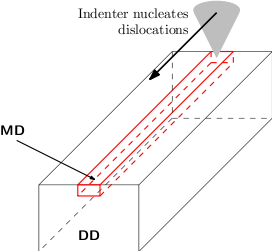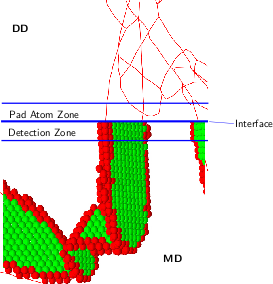Many phenomena in crystalline metals such as friction, nano-indentation and ductile fracture are plasticity-driven and poorly understood. The physical complexity is further increased by the inherently multiscale nature of contact and fracture. This study is aimed at a realistic numerical treatment of plasticity during nanoscale simulation of crystalline metal.
The principal mechanism of plasticity is dislocation nucleation and motion. Nucleation is an atomic nanoscale phenomenon and is often localised at interfaces, crack tips, etc., while dislocation motion is a microscale phenomenon occurring within grains in a polycrystalline microstructure. The molecular dynamics (MD) method is able to accurately predict dislocation nucleation, however the time and length scale limitations of MD do not permit for the description of the motion of the entire dislocation network. These are computed much more efficiently with the discrete dislocation dynamics (DD) method where the details of the atomistic configurations are eliminated.
In collaboration with Professor Curtin, we are working on a method to extend to 3D the coupled atomistics and discrete dislocations (CADD) method. To date, CADD has been restricted to plane strain problems with straight dislocations. In 3D CADD, the solid is split into two regions (e.g., Figure 1): the MD region, where highly non-linear deformations (i.e., dislocation nucleation) and complex defect interactions are expected to require an atomic resolution, and the DD region, where plastic behaviour modeled by the collective dislocation motion which be computed at a much lower cost. To couple these regions, the MD/DD interface (see Figure 2) uses a layer in the MD region where approaching dislocations are detected and a layer in the DD region where fictitious pad atoms provide boundary conditions for the MD region.
 |
 |
| Figure 1: Separation into MD and DD | Figure 2: Coupled representation |
Dislocations situated in MD and DD regions at a same time are called hybrid dislocations. Such a hybrid dislocation has two different representations despite being a single object. A proper treatment of these hybrid dislocations is addressed by CADD3D by coupling the two different dislocations. A first CADD3D test problem considers a hybrid straight mixed dislocation. The two representations are coupled through a “pad” zone, while they motion and propagate as a single dislocation.
The second test problem considers a hybrid dislocation loop where several character angles from edge to screw have to be considered. Again, the alogithm allows the two dislocation representations to expand as would do a single loop.
Using this CADD3D methodology, several dislocation dynamic problems can be studied. One of the phenomenon responsible for plastic flow is the continuous dislocation nucleation due to defects such as Frank-Read sources (go to dislocation nucleation and motion).
With CADD3D we can model the nucleation procedure in a molecular dynamics region whereas the expansion, over very large distances, can be handled by dislocation dynamics. The video below shows the dislocation emissions and evolutions around a Franck-Read source.
